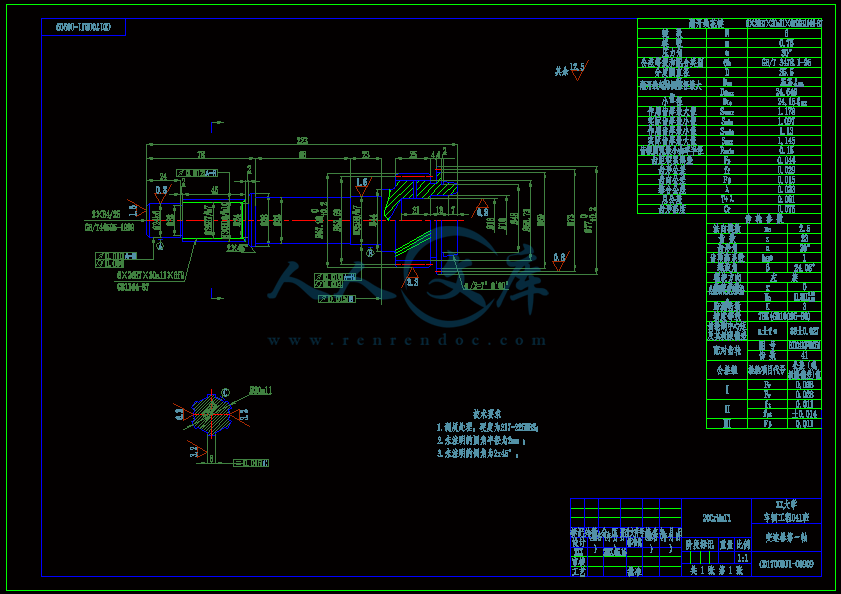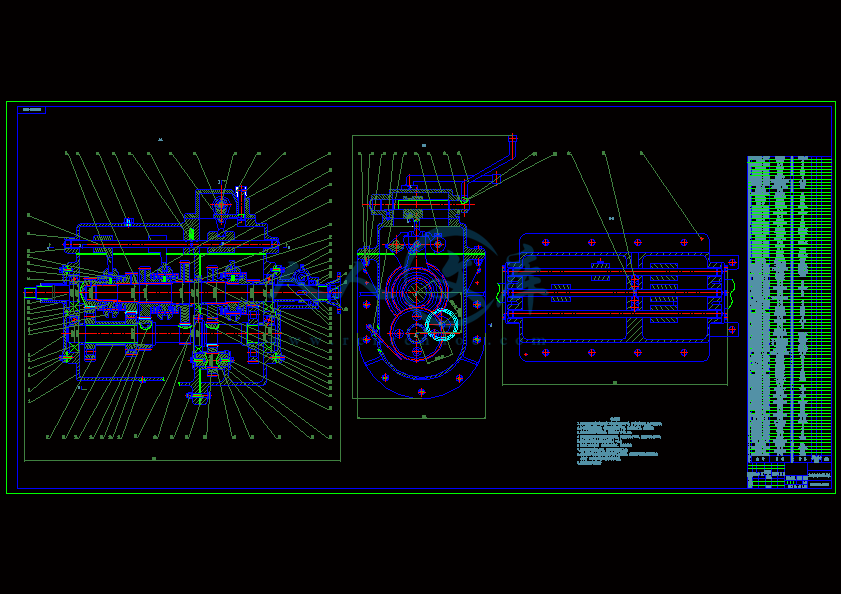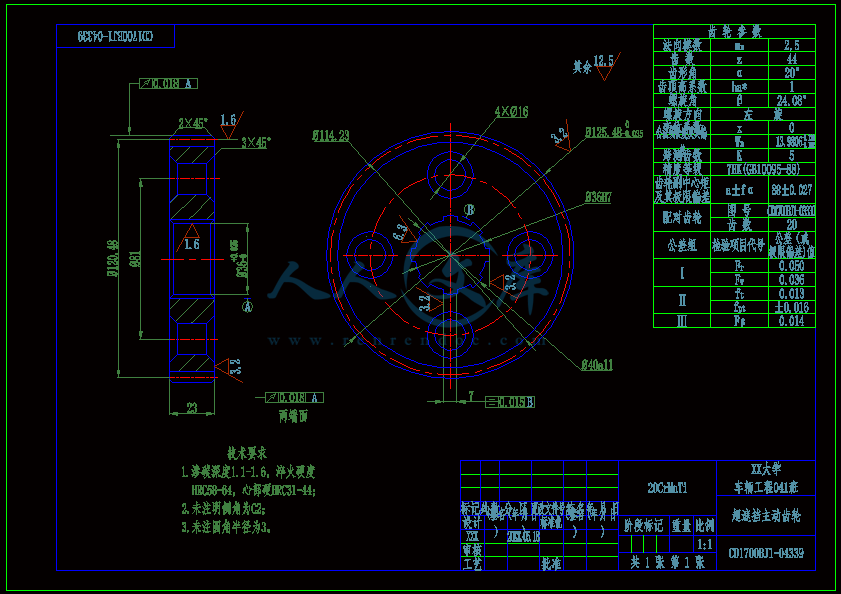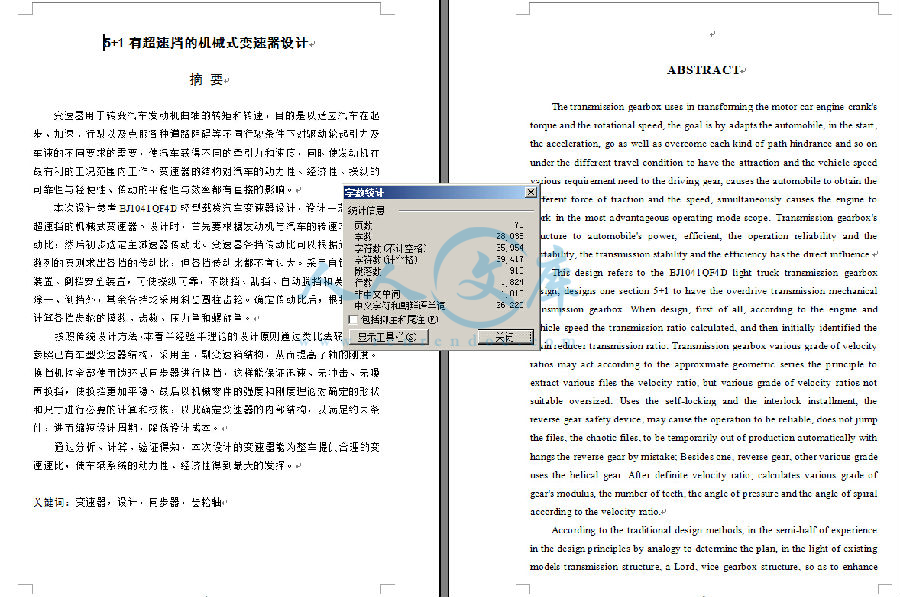5+1有超速挡的机械式变速器设计(汽车专业优秀毕业设计含全套CAD图纸)
收藏
资源目录

压缩包内文档预览:(预览前20页/共71页)
编号:6121361
类型:共享资源
大小:9.62MB
格式:ZIP
上传时间:2017-11-23
上传人:机****料
认证信息
个人认证
高**(实名认证)
河南
IP属地:河南
50
积分
- 关 键 词:
-
超速
机械式
变速器
设计
汽车
专业
优秀
优良
毕业设计
全套
cad
图纸
- 资源描述:
-












- 内容简介:
-
1GM Developing Smarter CarsWhen drivers are distracted, inattentive, or otherwise not doing what theyre supposed to be doing while behind the wheel, communications technology, sensors, GPS, and powerful processors just might make all the difference, as a General Motors demonstration proves. Traffic congestion caused 3.7-billion hours of travel delays, wasting 2.3-billion gallons of gasoline and $63 billion in 2003, according to the 2005 Urban Mobility Report issued by the Texas Transportation Institute. Thats missed meetings, late arrivals to the office and cold suppers on the table. Whats a nation laden in debt to do to help alleviate the problem, short of spending trillions on new road projects to accommodate the millions of vehicles added to the infrastructure each year? Experts say businesses should promote telecommuting, using the Internet and telephone for meetings, along with utilizing technology to monitor traffic flow, reducing accidents and improving throughput. The latter solution is the one General Motors is focusing on, including whats called vehicle-to-vehicle communications technology (V2V).A test drive in a Cadillac CTS equipped with V2V demonstrated two key uses of the system:lane change/blind spot warning and forward collision avoidance with auto-brake. During the lane change test, my green CTS cruised along the GM test track in Milford, MI, at a comfortable 40 mph, while silver CTS rode alongside directly in my blind spot. When I tried to make a lane change, using the turn signal, a yellow warning light flashed in the side-view mirror, providing a clear indication that a vehicle was present. A second test was done traveling at the same speed although this time the silver CTS approached the left side of the vehicle at a high rate of speed. Using the turn signal to indicate a lane change, the V2V system received a signal from the approaching silver CTS and immediately illuminated the warning light and sent a gentle vibration through the left side of the drivers seat, indicating a potential collision could occur, prompting me to stay in my lane. Once the lane change tests were complete, it was on to the collision avoidance round. Here, the first test involved the previously mentioned silver 2CTS, along with a black Suburban. As the silver CTS cruised along at 35mph, the driver performed an abrupt stop, forcing the Suburban to make a quick lane change. The V2V system immediately recognized the silver CTS was moving slowly and flashed a warning light on the dashboard of my test CTS and sent a gentle vibration to the front of the drivers seat. Additionally, the silver CTS rear brake and reverse lamps began flashing like strobes, providing an added visual warning, all which allowed for quick stopping before a rear-end collision happened. The next test was the most disconcerting of them all: Auto-brake. During the test, I approached the silver CTS, which was at a dead stop, at approximately 35 mph. As I neared the rear of the silver CTS, its rear tail lamps and reverse lights began blinking, to get my attention. In addition to which, a warning light lit on the dash of my car, and the front of my seat began vibrating. And as I kept approaching the silver CTS, the braking system of my car took over and automatically brought the vehicle to a stop before I could rear-end the other car. It was hard not to stomp on the brake as my car approached the silver CTS, but I managed to keep my composure OK, so I tapped on the brake slightly.HOW DOES V2V WORK?The V2V system uses GMs OnStar and Stabilitrak technology, along with a simple antenna and computer chip, to detect the position and movement of similarly-equipped vehicles, up to a quarter-mile. Signals between vehicles are communicated over a WiFi network using the 80.211Ip protocol, which has been assigned by the Federal Communications Commission for wireless access in vehicles because of its improved range and speed on the dedicated 5.9 GHz band. “You have got your GPS information on OnStar and youve got your wheel-spinning rates and yaws and all the other information you get from Stabilitrak and we take those two pieces of information and we put the mathematical algorithms together that not only tell you where the car is, but gives you dead reckoning insight on where its headed. Thats where we think we have some intellectual advantage,” says Larry Burns, GMs vice president-research and development and strategic planning, who envisions the system reaching production within the next five to 10 years. He compares the system to transponders used in the airline industry, where most civil aircraft are required to have transponders that 3communicate where they are located during flight. “You can think about a future world where all cars have to have a transponder. Some of the cars would take advantage of that in an active sense, saying if I know where every car is I have got this sixth sense on the vehicles and make my driving task easier, safer and more effective.”V2V FOR ALL? The V2V system is unique to GM, but the auto maker is interested in working with Federal regulators and competitors to make the system ubiquitous. “We will work with all the other stakeholders to make this work,” Burns says. GM believes the vehicle-to-vehicle communications approach to reducing traffic congestion and accidents is a more realistic way to improve vehicle throughput on highways, as opposed to other programs that call for installing magnetic pegs on roadsides and transponders in road signs. “The path to a smart transportation system is putting the intelligence on the vehicle and not in the roadway system. If you can communicate everything that you need to know about location and not have to do that with roadway infrastructure, thats a benefit,” Burns mentions. Plus, the additional antenna and sensor are minimal additional costBurns says its no more than the cost of the average cell phone. Compare that to spending trillions to put magnetic pegs every few feet on the 8,315,121-miles of roadways in the U.S. and you can see why it would be easier to spend a couple of bucks for an antenna and sensor on each car.The V2V system also marks another step on the path to autonomous vehicle travel, where the vehicle will be able to propel itself without input from the driver. Its a dream the industry has had for many years, but the technology has proven expensive and illusive, until the development of V2V, according to Burns. “When you see something like V2V and combine that with adaptive cruise control, you ask yourself How far are we from autonomous driving in a highway situation? Technologically, we are not that far away.” While the technology may be there, will drivers be willing to take their hands off the wheel and read their morning paper while going to work? Wait, many already do that. Stabilitrak is an integrated stability control system made up of three sensors that keep the anti-lock brake system and traction control computer apprised of steering 4wheel angle, lateral acceleration and yaw rate and selectively applies individual front brakes to keep the car on its intended course.Diesel vehiclesDiesel vehicles may be making a comeback. Diesel engines are more powerful and fuel-efficient than similar-sized gasoline engines (about 30-35% more fuel efficient). Plus, todays diesel vehicles are much improved over diesels of the past.Better Performance Improved fuel injection and electronic engine control technologies have Increased power Improved acceleration Increased efficiency New engine designs, along with noise- and vibration-damping technologies, have made them quieter and smoother. Cold-weather starting has been improved also.CleanerTodays diesels must meet the same emissions standards as gasoline vehicles, and advances in engine technologies, ultra-low sulfur diesel fuel, and improved exhaust treatment have made this possible.Although emissions of particulates and smog-forming nitrogen oxides (NOx) are still relatively high, new clean diesel fuels, such as ultra-low sulfur diesel and biodiesel, and advances in emission control technologies will reduce these pollutants also.Hybrid-electric vehiclesHybrid-electric vehicles (HEVs) combine the benefits of gasoline engines and electric motors and can be configured to obtain different objectives, such as improved fuel economy, increased power, or additional auxiliary power for electronic devices and power tools.Some of the advanced technologies typically used by hybrids include.Regenerative Braking. The electric motor applies resistance to the drive train causing the wheels to slow down. In return, the energy from the wheels turns the motor, 5which functions as a generator, converting energy normally wasted during coasting and braking into electricity, which is stored in a battery until needed by the electric motor.Electric Motor Drive/Assist. The electric motor provides additional power to assist the engine in accelerating, passing, or hill climbing. This allows a smaller, more efficient engine to be used. In some vehicles, the motor alone provides power for low-speed driving conditions where internal combustion engines are least efficient.Automatic Start/Shutoff. Automatically shuts off the engine when the vehicle comes to a stop and restarts it when the accelerator is pressed. This prevents wasted energy from idling.Flexible fuel vehicles (FFVs)Flexible fuel vehicles (FFVs) are designed to run on gasoline or a blend of up to 85% ethanol (E85). Except for a few engine and fuel system modifications, they are identical to gasoline-only models.FFVs have been produced since the 1980s, and dozens of models are currently available. Since FFVs look just like gasoline-only models, you may have an FFV and not even know it. To determine if your vehicle is an FFV, check the inside of your cars fuel filler door for an identification sticker or consult your owners manual.FFVs experience no loss in performance when operating on E85. However, since a gallon of ethanol contains less energy than a gallon of gasoline, FFVs typically get about 20-30% fewer miles per gallon when fueled with E85.Electric vehicles (EVs)Electric vehicles (EVs) are propelled by an electric motor (or motors) powered by rechargeable battery packs. Electric motors have several advantages over internal combustion engines (ICEs):Energy efficient. Electric motors convert 75% of the chemical energy from the batteries to power the wheels-internal combustion engines (ICEs) only convert 20% of the energy stored in gasoline.6Environmentally friendly. EVs emit no tailpipe pollutants, although the power plant producing the electricity may emit them. Electricity from nuclear-, hydro-, solar-, or wind-powered plants causes no air pollutants.Reduce energy dependence. Electricity is a domestic energy source.Performance benefits. Electric motors provide quiet, smooth operation and stronger acceleration and require less maintenance than ICEs.The Down Side: BatteriesEVs face significant battery-related challenges:Driving Range. Most EVs can only go 150 miles (or less) before recharging-gasoline vehicles can go over 300 miles before refueling.Recharge time. Fully recharging the battery pack can take 4 to 8 hours.Battery cost: The large battery packs are expensive and usually must be replaced one or more times.Bulk & weight: Battery packs are heavy and take up considerable vehicle space.Researchers are working on improved battery technologies to increase driving range and decrease recharging time, replacement frequency, weight, and cost. These factors will ultimately determine the future of EVs.外文资料译文 1通用汽车公司制造出更加奇妙的汽车当驾驶员不注意,精力不集中,或他们不应该做什么而驾驶时,他们总是在驾驶遇到一些障碍的时候才会做出反应,其汽车中交流技术、传感器、全球定位系统和强大的处理器发挥的能力可能有所不同,正如通用汽车作为示范证明。根据 2005 年由美国得克萨斯州运输研究所所发出的城市流动性报告,在2003 年当中,由于交通阻塞导致了 37 亿小时旅行延迟;浪费了 2.3 亿加仑汽油和 630 亿美元。那些误时错过的会议,以及办公室内上班的迟到和碰上宴席结束的残羹冷炙。那什么可以尽量减少这些出现的问题呢?那就投资道路建设,以较短的时间内来完善每年增加的道路基础设施项目,用来满足日益增长的汽车上路量。专家指出,企业也应促进远程办公,利用互联网和电话会议,利用技术以监察交通流量,减少意外事故。后者正是通用汽车解决办法的一个重点,正所谓“车对车通讯技术(V2V)” 。试驾一辆装备有 V2V 技术的凯迪拉克汽车表明,拥有两个关键用途的系统:车道变更/盲人车道警告和前瞻性,避免碰撞自动刹车。在车道变动测试期间,在通用公司的米尔福德测试轨道上,当乘坐的银色卡迪拉克 CTS 在接近旁边的盲人车道时,我的卡迪拉克 CTS 在以 40 公里/时的速度行驶。当我设法做车道变更, 发出变更车道信号时,在后视镜里一个黄色警告灯闪动了, 提供了一个清除指示, 旁边有车存在。第二个测试是以同样速度完成旅行,此时银色卡迪拉克 CTS 高速行驶将要接近这辆车时,再次发出信号灯表明要变更车道, 凯迪拉克中的 V2V系统接受了接近的银色凯迪拉克 CTS 的信号,并立即发出警告灯,同时传送出柔和的振动给驾驶员的座位上, 表明了潜在可能发生的碰撞, 提示我停留在车道上。如果道变动测试是完整的,它将打开碰撞退避按钮。这里, 第一次测试是在黑色的郊区先前被提及的银色卡迪拉克 CTS。当银色 CTS 巡航在 35 英里/小时,司机突然进行了中止,强迫在郊区做一条快的车道变更。 V2V 系统立刻认可了我的银色 CTS,慢慢地移动并且在我的测试 CTS 仪表板上闪动了的一个警告灯,而且传送了柔和的振动到驾驶员的前面。 另外,银色 CTS 的后制动和反向灯开始象闪光灯一样闪动,提供一个附加的视觉警告,在尾端碰撞发生之前考虑到所有的快停止。下一个测试最令他们不安的:自动刹车。 在测试期间,我以车速为 35外文资料译文 2公里/时接近了银色卡迪拉克 CTS 时,踩死刹车踏板。 因为我接近了银色 CTS的后方,它的后尾灯和反向光开始发出信号让我晃眼,引起了我的注意。除了那些之外,在我的汽车里的 V2V 系统也接收到信号,在我的座位前开始振动。当我继续接近银色凯迪拉克 CTS 时,我的汽车制动系统控制了我的汽车,并且在接近前方另一辆汽车时自动的停止。不用力踏制动板是困难的,因为我的汽车接近了银色凯迪拉克 CTS,但是我尽力保持镇静,因此我可以轻微地踩下了制动踏板。 V2V 的工作原理是什么呢 ? 该 V2V 系统采用通用汽车的 Onstar 和 Stabilitrak 技术,一个简单的天线与计算机芯片联接,在行驶速度的四分之一英里,探测装有同样装备的相似车辆的方位和运动。在行驶车辆的信号之间使用 80.211TCP/IP 协议传送一个 WiFi 网络。该协议书由美国联邦通信委员会指派了在车辆上无线网络的接入,由于它使用的是一种范围和速度都在 5.9 千兆赫兹的专用传播频段。通用汽车战略发展部的主管拉里伯恩斯说:“你所使用的全球定位系统信息是关于 OnStar,并且你也可以从你所驾驶的汽车中获得,你能从 Stabilitrak 中得到的其它所有信息。当我们获得这两种信息时,我们不仅汇集到告诉您的汽车信息接收是在什么地方,而且给你所使用的洞察力推测地方航行的办法。这也就是我们认为我们有一些智力优势的地方。 ”这是美国通用汽车的副总副裁所研究与发展的战略规划,这个系统构想将会在未来 5 到 10 年之内成为现实。它与转发器比较系统都将在航空业被使用,而大多数民用飞机在它们飞行期间须有转发通信。 “你可以想想,在未来的世界里,从积极的意义上说所有的汽车将利用一个转发器。一些汽车将会利用这些紧绷的触觉,如果说我将知道每辆汽车都有的话,那样我在驾驶时也有会有第六感,并且使我驾驶起来更加轻松, 更加安全、有效。 ”V2V 是汽车的全部吗 ? 该 V2V 系统是通用汽车所独有的,但是汽车制造商却在面对联邦管理者和竞争者所感兴趣系统做出普遍存在的反应。伯恩斯说:“我们将使这项工作与所有其他利益相关者作为赌注” 。通用汽车认为,减少交通阻塞和事故的发生汽车对汽车通信方法是一个更加较为现实的途径。用以改善在行驶在公路上的车流量,与要求那些安装在路旁磁性钉和转发器在道路旁道路标志的其它项目相对。伯恩斯提及:“道路交通运输系统是汽车在道路上行驶时把情报传给汽车。如果你能外文资料译文 3通信您所需要知道的全部方位,那就不必做那些车行道基础设施, 那也只有受益。另外,无线网络和传感器是极少的支出成本。 ”它的成本比我们使用的平均手机费还低。在美国,与消费者相比较的那些投入在 8,315,121 英里车道上,每隔几只脚的距离就有放磁性钉相比,你就能看到为什么在各种汽车上安装使用无线网络和传感器技术更加容易。 V2V 系统也有为自驾车旅行中道路标识,汽车可以在没有司机驾驶的情况下进行行驶。这是许多年来汽车行业的梦想,但是事实技术证明,这只是高价和理想化状态。直到 V2V 系统的发展。伯恩斯“当您看某事像 V2V 系统并且与能适应的导航,并能与其相适应的驾驶控制相结合时,您所要求的需要,何时我们才能在高速公路情况中自动驾驶?从技术上来说,那并不是那么遥远。当这种技术也许成为现实时,驾驶员将愿意放开他们手中的方向盘而去读他们的晨报或去做其他的事情。就让我们期待吧,也许在不久的将来就会实现的。 Stabilitrak 是一个联合稳定控制系统,它由三个传感器所组成。 使汽车防抱死制动系统和牵引控制计算机熟
- 温馨提示:
1: 本站所有资源如无特殊说明,都需要本地电脑安装OFFICE2007和PDF阅读器。图纸软件为CAD,CAXA,PROE,UG,SolidWorks等.压缩文件请下载最新的WinRAR软件解压。
2: 本站的文档不包含任何第三方提供的附件图纸等,如果需要附件,请联系上传者。文件的所有权益归上传用户所有。
3.本站RAR压缩包中若带图纸,网页内容里面会有图纸预览,若没有图纸预览就没有图纸。
4. 未经权益所有人同意不得将文件中的内容挪作商业或盈利用途。
5. 人人文库网仅提供信息存储空间,仅对用户上传内容的表现方式做保护处理,对用户上传分享的文档内容本身不做任何修改或编辑,并不能对任何下载内容负责。
6. 下载文件中如有侵权或不适当内容,请与我们联系,我们立即纠正。
7. 本站不保证下载资源的准确性、安全性和完整性, 同时也不承担用户因使用这些下载资源对自己和他人造成任何形式的伤害或损失。

人人文库网所有资源均是用户自行上传分享,仅供网友学习交流,未经上传用户书面授权,请勿作他用。
 川公网安备: 51019002004831号
川公网安备: 51019002004831号